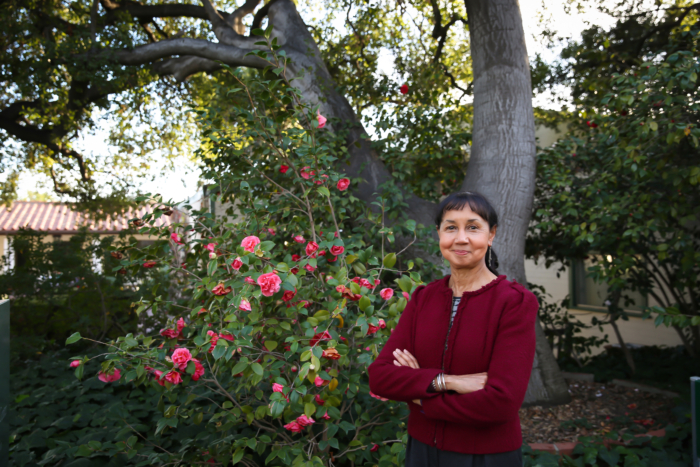
Rita Roberts is a professor of history and Africana studies and the Nathaniel Wright Stephenson Chair in History and Biography at Scripps College. She is a central part of multiple programs at Scripps and across The Claremont Colleges, including the History Department, the Intercollegiate Department of Africana Studies, and the American Studies Program, and she has taught in all three courses of the Core Program in Interdisciplinary Humanities. Her courses engage students in the study of the history of the early United States, 16th- through 21st-century African American history, African diaspora, black intellectuals and the politics of race, and the modern Civil Rights Movement, among other topics. She holds master’s and PhD degrees in history from the University of California, Berkeley. We interviewed her as part of our ongoing Spotlight on Faculty series.
Scripps College: Your first book forms an account of America’s antebellum past through the writings and speeches of some of the major African American intellectuals who were abolitionist figures during that time. Now, in your research for your second book, you are examining letters—African American correspondence during the Civil War era. Can you share some of your findings?
Rita Roberts: So much focus has been on what has been done to African Americans, I think it’s important to understand what African Americans did. In my first book, Evangelicalism and the Politics of Reform in Northern Black Thought, 1776–1863, I was able to present the words of influential black men and women in the North that helped shape the abolitionist movement and shared their vision of a true republic as evangelical Christians. This book is used in graduate programs and read mainly by scholars in the field. My next book, which I researched from 2010 to 2016 by traveling to primary source locations, from New Orleans to New York, Boston, Savannah, Philadelphia, and Washington, presents original letters written from the 1850s to the late 1870s, an era people are generally interested in, but actually know very little about. I hope the book will make this period in history accessible to the general public—they will see copies of handwritten letters and my annotations that contextualize the events of the day.
I have studied, copied, or transcribed over 150 letters and have organized the book mostly chronologically, from pre–Civil War through Reconstruction, along themes that depict African American experiences. For example, there are poignant letters, such as one of a wife imploring her husband to purchase her for fear that she will be sold to the Deep South and may never see him again. Another letter, from a wife of a Union soldier, informs him their child has died. There are letters written by African Americans in response to the death of Abraham Lincoln. There are also accounts of newly freed people’s aspirations to unite their families, own land, establish independence, earn wages, and found and attend schools and churches. Many of the letters reflect the beautiful penmanship of the day, yet words are sometimes spelled phonetically. Some letters are written in the writers’ own hand, and some are transcribed by others on their behalf. It’s an amazing, first-person journey through history. I have divided the letters into public and private chapters within a specific period. These letters tell very real, very personal stories that bring history to life.
SC: What are some of your favorite memories teaching in the Core Curriculum in Interdisciplinary Humanities, the College’s signature interdisciplinary approach to learning that has sometimes been called “mind bending” for students?
RR: I think Core is one of the best programs we have at Scripps. I was here before Core was established, and I think it has changed our students’ abilities to think critically. They have a more critical and evolving theoretical lens, even as second- or third-year students. I taught a Core III course on colonialism, imperialism, and race in the U.S., in which students read a whole lot and asked for more. I love teaching Core II now with Warren Liu; he is a gentle and insightful teacher and scholar who looks at the close reading of the texts we study, while I look at the broader picture and the context in which it was written. Core I gives first-year students a way of looking at historical, political, social, and economic narratives in a way they might not have in high school. It helps them see beyond simplistic approaches to understand the complexities of the past and present.
SC: Some still talk about the compelling convocation speech you gave in 2015, that, among other stirring notes, called on students to “look deeper and harder” to the manifestations of racism around us today, and you are known for continuing to mentor and inspire—what words do you have for all to continue to move out of our current racial paradigm?
This is a question I think about almost every day. I think we have to unlearn as much as we learn. We need to develop a more critical mindset about what we know and constantly challenge who we are and what we do as teachers and as individuals who might be interested in interacting in different ways with all kinds of people. Perhaps the most horrific thing in the U.S. is that we continue to think racially: this continues to reify the inequality problems in our society, including mass incarcerations, disenfranchisement, inequities in education, and so on. We need to look at the way race defines our lives. It is not an intractable problem if we think about it—we have a large segment of the population that is still unwilling to admit that race dominates our political, economic, and social world.
SC: Is there a fact about yourself that is surprising, or that people don’t know about, that you’d like to share?
RR: I work out at the gym three times a week and have my own personal trainer.

